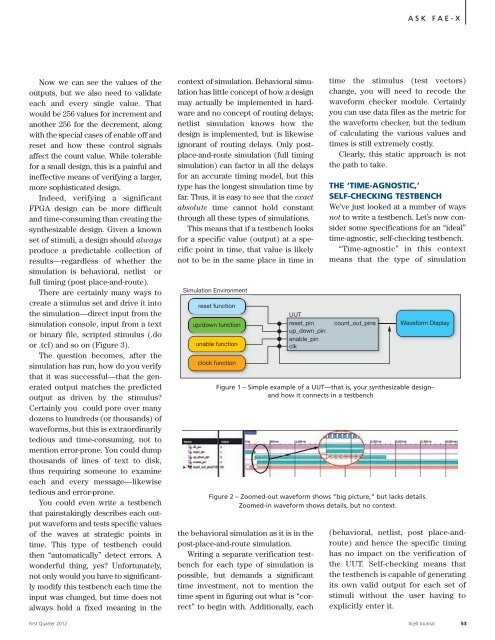Xcell Journal Issue 78: Charge to Market with Xilinx 7 Series ...
Xcell Journal Issue 78: Charge to Market with Xilinx 7 Series ...
Xcell Journal Issue 78: Charge to Market with Xilinx 7 Series ...
You also want an ePaper? Increase the reach of your titles
YUMPU automatically turns print PDFs into web optimized ePapers that Google loves.
Now we can see the values of the<br />
outputs, but we also need <strong>to</strong> validate<br />
each and every single value. That<br />
would be 256 values for increment and<br />
another 256 for the decrement, along<br />
<strong>with</strong> the special cases of enable off and<br />
reset and how these control signals<br />
affect the count value. While <strong>to</strong>lerable<br />
for a small design, this is a painful and<br />
ineffective means of verifying a larger,<br />
more sophisticated design.<br />
Indeed, verifying a significant<br />
FPGA design can be more difficult<br />
and time-consuming than creating the<br />
synthesizable design. Given a known<br />
set of stimuli, a design should always<br />
produce a predictable collection of<br />
results—regardless of whether the<br />
simulation is behavioral, netlist or<br />
full timing (post place-and-route).<br />
There are certainly many ways <strong>to</strong><br />
create a stimulus set and drive it in<strong>to</strong><br />
the simulation—direct input from the<br />
simulation console, input from a text<br />
or binary file, scripted stimulus (.do<br />
or .tcl) and so on (Figure 3).<br />
The question becomes, after the<br />
simulation has run, how do you verify<br />
that it was successful—that the generated<br />
output matches the predicted<br />
output as driven by the stimulus?<br />
Certainly you could pore over many<br />
dozens <strong>to</strong> hundreds (or thousands) of<br />
waveforms, but this is extraordinarily<br />
tedious and time-consuming, not <strong>to</strong><br />
mention error-prone. You could dump<br />
thousands of lines of text <strong>to</strong> disk,<br />
thus requiring someone <strong>to</strong> examine<br />
each and every message—likewise<br />
tedious and error-prone.<br />
You could even write a testbench<br />
that painstakingly describes each output<br />
waveform and tests specific values<br />
of the waves at strategic points in<br />
time. This type of testbench could<br />
then “au<strong>to</strong>matically” detect errors. A<br />
wonderful thing, yes? Unfortunately,<br />
not only would you have <strong>to</strong> significantly<br />
modify this testbench each time the<br />
input was changed, but time does not<br />
always hold a fixed meaning in the<br />
context of simulation. Behavioral simulation<br />
has little concept of how a design<br />
may actually be implemented in hardware<br />
and no concept of routing delays;<br />
netlist simulation knows how the<br />
design is implemented, but is likewise<br />
ignorant of routing delays. Only postplace-and-route<br />
simulation (full timing<br />
simulation) can fac<strong>to</strong>r in all the delays<br />
for an accurate timing model, but this<br />
type has the longest simulation time by<br />
far. Thus, it is easy <strong>to</strong> see that the exact<br />
absolute time cannot hold constant<br />
through all these types of simulations.<br />
This means that if a testbench looks<br />
for a specific value (output) at a specific<br />
point in time, that value is likely<br />
not <strong>to</strong> be in the same place in time in<br />
Simulation Environment<br />
reset function<br />
up/down function<br />
unable function<br />
clock function<br />
UUT<br />
reset_pin<br />
up_down_pin<br />
enable_pin<br />
clk<br />
the behavioral simulation as it is in the<br />
post-place-and-route simulation.<br />
Writing a separate verification testbench<br />
for each type of simulation is<br />
possible, but demands a significant<br />
time investment, not <strong>to</strong> mention the<br />
time spent in figuring out what is “correct”<br />
<strong>to</strong> begin <strong>with</strong>. Additionally, each<br />
ASK FAE-X<br />
time the stimulus (test vec<strong>to</strong>rs)<br />
change, you will need <strong>to</strong> recode the<br />
waveform checker module. Certainly<br />
you can use data files as the metric for<br />
the waveform checker, but the tedium<br />
of calculating the various values and<br />
times is still extremely costly.<br />
Clearly, this static approach is not<br />
the path <strong>to</strong> take.<br />
THE ‘TIME-AGNOSTIC,’<br />
SELF-CHECKING TESTBENCH<br />
We’ve just looked at a number of ways<br />
not <strong>to</strong> write a testbench. Let’s now consider<br />
some specifications for an “ideal”<br />
time-agnostic, self-checking testbench.<br />
“Time-agnostic” in this context<br />
means that the type of simulation<br />
count_out_pins<br />
Waveform Display<br />
Figure 1 – Simple example of a UUT—that is, your synthesizable design–<br />
and how it connects in a testbench<br />
Figure 2 – Zoomed-out waveform shows “big picture,” but lacks details.<br />
Zoomed-in waveform shows details, but no context.<br />
(behavioral, netlist, post place-androute)<br />
and hence the specific timing<br />
has no impact on the verification of<br />
the UUT. Self-checking means that<br />
the testbench is capable of generating<br />
its own valid output for each set of<br />
stimuli <strong>with</strong>out the user having <strong>to</strong><br />
explicitly enter it.<br />
First Quarter 2012 <strong>Xcell</strong> <strong>Journal</strong> 53

















